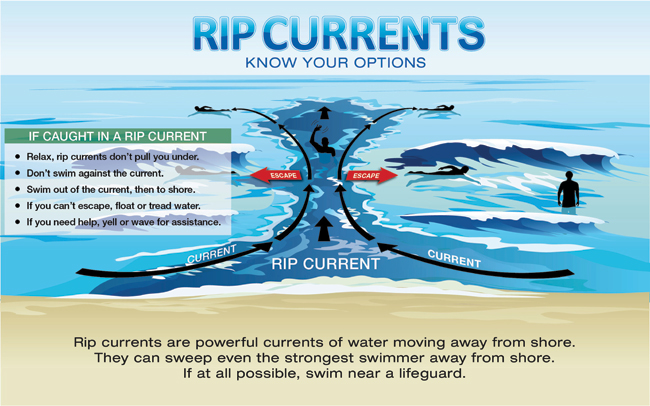
Graphic: NOAA Rip Current safety information. Credit: weather.gov
Contact:
Kathleen Fallon, NYSG Coastal Processes & Hazards Specialist, P: 631-632-8730, E: kmf228@cornell.edu
New York Sea Grant partnered with MARACOOS to create a Long Island-based network for rip current science and safety professionals
Stony Brook, NY, March 8, 2021 - Rip currents are considered to be the number one beach hazard due to the number of fatalities that occur each year when beachgoers are pulled away from shore by the powerful fast-moving water. The National Ocean Service of the National Oceanic and Atmospheric Administration estimates that a rip current can move at a speed of eight feet per second. Many professionals in the fields of research, forecasting, safety, and education are working to further the understanding of rip current science to reduce the number of related incidents. Until now, these professionals on Long Island had had little to no cross-communication.
In 2020, New York Sea Grant and the Mid-Atlantic Regional Association Coastal Ocean Observing System (MARACOOS) created the Long Island Rip Current Network (LIRN) as a framework for promoting collaboration and effective communications aimed at enhancing efforts, reducing duplication, and, ultimately, reducing rip current-related incidents.
The initial steps included developing a list of professionals to be included in the network. Over the summer of 2020, a survey was developed and distributed via email to gauge interest in the development of the network as well as to identify relevant topics for discussion at a workshop. The survey had a response rate of over 75%, and obtained important information, such as, the education of beachgoers being of highest interest to the rip current professionals. There was widespread interest in participating in the proposed network and in fostering relationships across Long Island and within the larger Mid-Atlantic region.
In the fall, NYSG and MARACOOS co-hosted the first LIRN Workshop. A dozen representatives from such sectors as academia, forecasting, municipalities, and lifeguard organizations participated in identifying clearly-defined goals for the new network and the next steps for its development. NYSG plans to host at least one more workshop before the summer 2021 beach season. This network of rip current professionals on Long Island will work together to research, educate, and reduce the number of rip current-related fatalities that occur each year.
Learn more at www.nyseagrant.org/ripcurrents.
Project Partners:
• Mid-Atlantic Regional Association Coastal Ocean Observing System
More Info: New York Sea Grant
New York Sea Grant (NYSG), a cooperative program of Cornell University
and the State University of New York (SUNY), is one of 34 university-based
programs under the National Oceanic and Atmospheric Administration’s
National Sea Grant College Program.
Since 1971, NYSG has represented a statewide network of integrated
research, education and extension services promoting coastal community
economic vitality, environmental sustainability and citizen awareness
and understanding about the State’s marine and Great Lakes resources.
Through NYSG’s efforts, the combined talents of university scientists
and extension specialists help develop and transfer science-based
information to many coastal user groups—businesses and industries,
federal, state and local government decision-makers and agency managers,
educators, the media and the interested public.
The program maintains Great Lakes offices at Cornell University, SUNY
Buffalo, SUNY Oswego and the Wayne County Cooperative Extension office
in Newark. In the State's marine waters, NYSG has offices at Stony Brook
University in Long Island, Brooklyn College and Cornell Cooperative
Extension in NYC and Elmsford and Kingston in the Hudson Valley.
For updates on Sea Grant activities: www.nyseagrant.org has RSS, Facebook, Twitter, Instagram, and YouTube links. NYSG offers a free e-list sign up via www.nyseagrant.org/nycoastlines for its flagship publication, NY Coastlines/Currents, which is published quarterly.